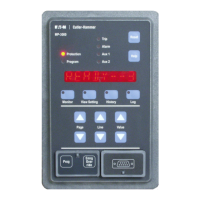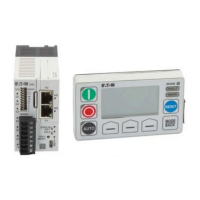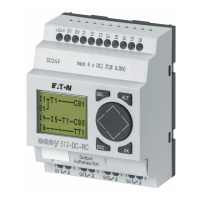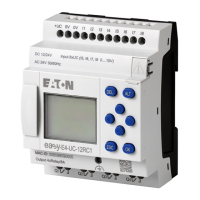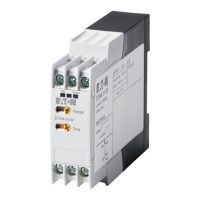IL17569
Page 5-36
Effective June, 2001
defined by the ratio of negative sequence voltage to positive
sequence voltage (% Unbalance=V2/V1), or %(V2/V1) for ABC
rotation and %(V1/V2) for ACB rotation. The FP-5000 will automati-
cally select the correct ratio based on the Phase Sequence setting
in the System Configuration group described above.
The time delay is a definite time delay adjustable from 0 to 9999
cycles in 1 cycle steps.
This function requires positive or negative sequence voltage
magnitude above the threshold setting and the percentage voltage
unbalance above the %(V2/V1) setting before allowing a voltage
unbalance trip. Therefore, both the threshold and percent settings
must be met for the specified Delay time setting before the relay
initiates a trip for voltage unbalance.
The voltage unbalance pickup and trip functions are reset when the
positive and negative sequence voltages V1 and V2 drop below the
Threshold setting or (V2/V1) drops below the %(V2/V1) setting
minus 1%.
46-1 Current Unbal
This is the 46 device Current Unbalance setting, which works similar
to the 47 device Voltage Unbalance setting. The positive and negative
sequence currents are calculated from the 3-phase currents.
The Threshold setting defines a minimum operating current
magnitude of either I1 or I2 for the 46 function to operate, which
insures that the relay has a solid basis for initiating a current
unbalance trip. This is a supervisory function and not a trip level.
The %(I2/I1) setting is the unbalance trip pickup setting. It is defined
by the ratio of negative sequence current to positive sequence
current (% Unbalance=I2/I1), or %(I2/I1) for ABC rotation and %(I1/
I2) for ACB rotation. The FP-5000 will automatically select the
correct ratio based on the Phase Sequence setting in the System
Configuration group described above.
The time delay is a definite time delay adjustable from 0 to 9999
cycles in 1 cycle steps.
This function requires positive or negative sequence current
magnitude above the threshold setting and the percentage current
unbalance above the %(I2/I1) setting before allowing a current
unbalance trip. Therefore, both the threshold and percent settings
must be met for the specified Delay time setting before the relay
initiates a trip for current unbalance.
The current unbalance pickup and trip functions are reset when
the positive and negative sequence current I1 and I2 drop below
the Threshold setting or (I2/I1) drops below the %(I2/I1) setting
minus 1%.
5.5.2.5 Voltage Protection Settings
27M-1 Undervoltage
This is the 27 device Undervoltage setting for the Main 3-phase VT.
This function consists of a Threshold V and Delay setting. The
Threshold V setting is the magnitude (10 to 150V in 1 volt steps) at
which the undervoltage function operates. The Delay setting (0 to
9999 cycles in 1 cycle steps) is the time period an undervoltage
must occur before the FP-5000 initiates a trip. This function will
operate if any of the 3-phase voltages drop below the set point. This
setting is based on line-to-line voltages for Delta configurations and
line-to-neutral voltages for a Wye configuration.
The undervoltage pickup and trip functions are reset when the
voltage raises above 102% of the undervoltage set threshold.
59M-1 Overvoltage
This is the 59 device Overvoltage setting for the Main VT. This
function consists of a Threshold V and Delay setting. The
Threshold V setting is the magnitude (10 to 150V in 1 volt steps) at
which the overvoltage function operates. The Delay setting (0 to
9999 cycles in 1 cycle steps) is the time period an overvoltage
must occur before the FP-5000 initiates a trip. This function will
operate if any of the 3-phase voltages rise above the set point. This
setting is based on line-to-line voltages for Delta configurations and
line-to-neutral voltages for Wye connections.
The overvoltage pickup and trip functions are reset when the
voltage drops below 98% of the overvoltage set threshold.
27A-1 Undervoltage
This is the 27 device Undervoltage setting for the Auxiliary VT. This
device setting works exactly the same as the 27-M1 device above
except it is a single-phase element only operating from the Auxiliary
VT input.
Note: The expanded threshold V setting range (10–250V) is
available for the Auxiliary Undervoltage setting.
59A-1 Overvoltage
This is the 59 device Overvoltage setting for the Auxiliary VT. This
device setting works exactly the same as the 59M-1 device above,
except it is a single-phase element only operating from from the
Auxiliary VT input.
Note: The expanded threshold V setting range (10–250V) is
available for the Auxiliary Overvoltage setting.
5.5.2.6 Frequency Protection Settings
81U-1 Underfreq
This is the 81U device Underfrequency setting. This function
consists of a Threshold and Delay setting. The Threshold setting is
the frequency (45-65 Hz in 0.01 Hz steps) below which the
underfrequency function operates. The Delay setting (0 to 9999
cycles in 1-cycle steps) is the time period an underfrequency must
occur before the FP-5000 initiates a trip.
The underfrequency pickup and trip functions are reset when the
frequency raises above the underfrequency set threshold.
Note: Phase A voltage must be greater than 10V for this function
to operate.
81O-1 Overfreq:
This is the 81O device Overfrequency setting. This function
consists of a Threshold and Delay setting. The Threshold setting is
the frequency (45-65 Hz in 0.01 Hz steps) above which the
overfrequency function operates. The Delay setting (0 to 9999
cycles) is the time period an overfrequency must occur before the
FP-5000 initiates a trip.
The overfrequency pickup and trip functions are reset when the
frequency drops below the overfrequency set threshold.
Note: Phase A voltage must be greater than 10V for this function
to operate.
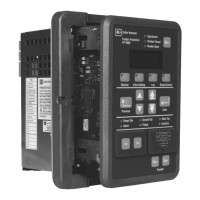
